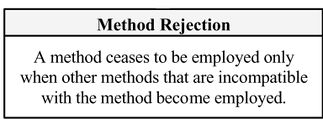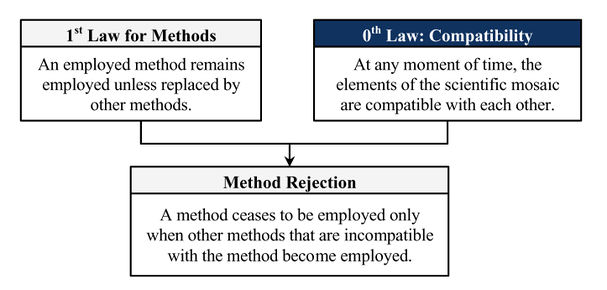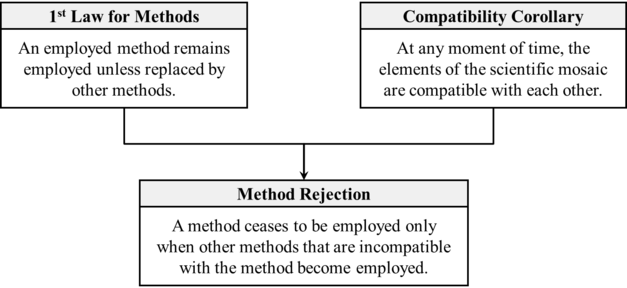Difference between revisions of "Method Rejection theorem (Barseghyan-2015)"
Izzy Friesen (talk | contribs) m |
|||
| (8 intermediate revisions by 3 users not shown) | |||
| Line 1: | Line 1: | ||
{{Theory | {{Theory | ||
| + | |Topic=Mechanism of Method Rejection | ||
| + | |Theory Type=Descriptive | ||
| + | |Subject= | ||
| + | |Predicate= | ||
|Title=Method Rejection theorem | |Title=Method Rejection theorem | ||
| − | | | + | |Alternate Titles= |
| − | |Formulation Text=A method ceases to be employed only when other methods incompatible with the method become employed. | + | |Title Formula= |
| + | |Text Formula= | ||
| + | |Formulation Text=A method ceases to be employed only when other methods that are incompatible with the method become employed. | ||
| + | |Object= | ||
| + | |Authors List=Hakob Barseghyan | ||
| + | |Formulated Year=2015 | ||
|Formulation File=Method-rejection-theorem-box-only.jpg | |Formulation File=Method-rejection-theorem-box-only.jpg | ||
| − | + | |Description=According to ''the method rejection theorem'', a [[Method|method]] ceases to be employed only when other methods that are incompatible with it become employed. | |
| − | + | |Resource=Barseghyan (2015) | |
| − | + | |Prehistory= | |
| − | |Description=According to ''the method rejection theorem'', a [[Method|method]] ceases to be employed only when other methods that are incompatible with it become employed. | + | |History=Initially, the '''method rejection theorem''' was accepted as deducible from the conjunction of [[The First Law (Barseghyan-2015)|the first law]] for methods and [[Rory Harder|Harder]]'s [[The Zeroth Law (Harder-2015)|zeroth law]]. Barseghyan noted that this initial deduction was "similar to that of the theory rejection theorem. And just as its sibling theory rejection theorem, this theorem is also somewhat trivial".[[CiteRef::Barseghyan (2015)|pp. 174]] |
| + | |||
{{PrintDiagramFile|diagram file=Method-rejection-theorem.jpg}} | {{PrintDiagramFile|diagram file=Method-rejection-theorem.jpg}} | ||
| − | + | ||
| + | We can use the short, hypothetical example from [[Barseghyan (2015)]] to illustrate the initial deduction of the '''method rejection theorem'''. | ||
| + | |||
| + | <blockquote>Say we have a set of accepted theories and a very simplistic method, which consists of only one requirement that can be roughly explicated as: | ||
| + | ''In order to become accepted, a new theory must explain all known facts with more precision and accuracy than they are explained by accepted theories.'' | ||
| + | Suppose also that, as a result of changes in the accepted theories, some new method becomes employed. Question: what happens to this old method? Does it get rejected or does it still remain employed together with the new one? | ||
| + | The answer to this question depends on whether the two methods can be employed simultaneously. By [[The Zeroth Law (Harder-2015)]], if the requirements of the two methods are compatible with each other, then the old method remains employed together with the new one or, conversely, if the requirements of the two methods are incompatible, then the zeroth law dictates that the old method should go. ... If our new method has no conflict between its new requirement and the old one – the two are complementary. Therefore, the two requirements will become simultaneously employed. But what if the new method were incompatible with the old method? ... This new requirement voids the old requirement. Thus, the new method is in conflict with the old method. In this case, by the law of compatibility, the old method will have to go.[[CiteRef::Barseghyan (2015)|pp. 172-3]] </blockquote> | ||
| + | |||
| + | After the replacement of Harder's zeroth law with [[Compatibility Corollary (Fraser-Sarwar-2018)|the compatibility corollary]], suggested by [[Patrick Fraser|Fraser]] and [[Ameer Sarwar|Sarwar]], it became accepted that the method rejection theorem is a deductive consequence of the first law for theories and the compatibility corollary.[[CiteRef::Fraser and Sarwar (2018)|pp. 72-74]] | ||
| + | |Page Status=Needs Editing | ||
}} | }} | ||
{{Acceptance Record | {{Acceptance Record | ||
| Line 20: | Line 39: | ||
|Acceptance Indicators=The theorem became ''de facto'' accepted by the community at that time together with the whole [[The Theory of Scientific Change|theory of scientific change]]. | |Acceptance Indicators=The theorem became ''de facto'' accepted by the community at that time together with the whole [[The Theory of Scientific Change|theory of scientific change]]. | ||
|Still Accepted=Yes | |Still Accepted=Yes | ||
| + | |Accepted Until Era= | ||
| + | |Accepted Until Year= | ||
| + | |Accepted Until Month= | ||
| + | |Accepted Until Day= | ||
|Accepted Until Approximate=No | |Accepted Until Approximate=No | ||
| + | |Rejection Indicators= | ||
}} | }} | ||
Latest revision as of 17:41, 24 February 2023
This is an answer to the question Mechanism of Method Rejection that states "A method ceases to be employed only when other methods that are incompatible with the method become employed."
Method Rejection theorem was formulated by Hakob Barseghyan in 2015.1 It is currently accepted by Scientonomy community as the best available answer to the question.
Contents
Scientonomic History
Initially, the method rejection theorem was accepted as deducible from the conjunction of the first law for methods and Harder's zeroth law. Barseghyan noted that this initial deduction was "similar to that of the theory rejection theorem. And just as its sibling theory rejection theorem, this theorem is also somewhat trivial".1pp. 174
We can use the short, hypothetical example from Barseghyan (2015) to illustrate the initial deduction of the method rejection theorem.
Say we have a set of accepted theories and a very simplistic method, which consists of only one requirement that can be roughly explicated as:
In order to become accepted, a new theory must explain all known facts with more precision and accuracy than they are explained by accepted theories. Suppose also that, as a result of changes in the accepted theories, some new method becomes employed. Question: what happens to this old method? Does it get rejected or does it still remain employed together with the new one?
The answer to this question depends on whether the two methods can be employed simultaneously. By The Zeroth Law (Harder-2015), if the requirements of the two methods are compatible with each other, then the old method remains employed together with the new one or, conversely, if the requirements of the two methods are incompatible, then the zeroth law dictates that the old method should go. ... If our new method has no conflict between its new requirement and the old one – the two are complementary. Therefore, the two requirements will become simultaneously employed. But what if the new method were incompatible with the old method? ... This new requirement voids the old requirement. Thus, the new method is in conflict with the old method. In this case, by the law of compatibility, the old method will have to go.1pp. 172-3
After the replacement of Harder's zeroth law with the compatibility corollary, suggested by Fraser and Sarwar, it became accepted that the method rejection theorem is a deductive consequence of the first law for theories and the compatibility corollary.2pp. 72-74
Acceptance Record
| Community | Accepted From | Acceptance Indicators | Still Accepted | Accepted Until | Rejection Indicators |
|---|---|---|---|---|---|
| Scientonomy | 1 January 2016 | The theorem became de facto accepted by the community at that time together with the whole theory of scientific change. | Yes |
Suggestions To Reject
These are all the modifications where the rejection of this theory has been suggested:
| Modification | Community | Date Suggested | Summary | Verdict | Verdict Rationale | Date Assessed |
|---|---|---|---|---|---|---|
| Sciento-2023-0002 | Scientonomy | 28 December 2023 | Accept new formulations of the first law for theories, norms, and questions that are in tune with the formulation of the first law. Also accept new formulations of the respective rejection theorems - theory rejection, norm rejection, and question rejection. | Open |
Question Answered
Method Rejection theorem (Barseghyan-2015) is an attempt to answer the following question: When does an employed method become rejected?
See Mechanism of Method Rejection for more details.
Description
According to the method rejection theorem, a method ceases to be employed only when other methods that are incompatible with it become employed.
Reasons
Reason: Method Rejection Theorem Deduction
By the first law for methods, an employed method will remain employed until it is replaced by other methods. By the compatibility corollary, the elements of the scientific mosaic are compatible with each other at any moment of time. Thus, a method can only become rejected when it is replaced by an incompatible method or methods.1pp. 172-176 2pp. 72-74
This reason for Method Rejection theorem (Barseghyan-2015) was formulated by Patrick Fraser and Ameer Sarwar in 2018.2
If a reason supporting this theory is missing, please add it here.
Questions About This Theory
The following higher-order questions concerning this theory have been suggested:
If a question about this theory is missing, please add it here.
References
- a b c d Barseghyan, Hakob. (2015) The Laws of Scientific Change. Springer.
- a b c Fraser, Patrick and Sarwar, Ameer. (2018) A Compatibility Law and the Classification of Theory Change. Scientonomy 2, 67-82. Retrieved from https://scientojournal.com/index.php/scientonomy/article/view/31278.


